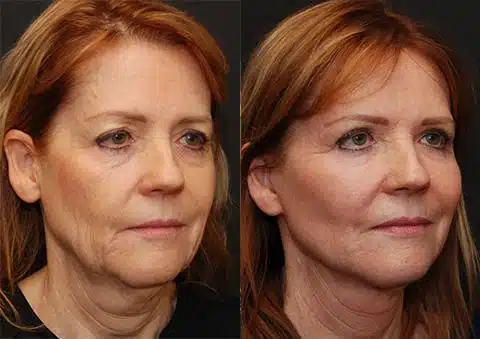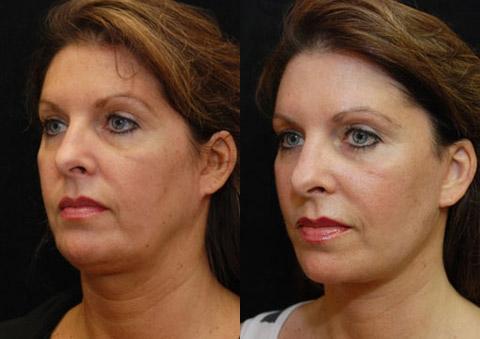Ever wondered if you could turn back the clock, without the long downtime of traditional facelift surgery? The mini facelift might be exactly what you’re looking for. This refined, less invasive version of the facelift offers visible rejuvenation with a shorter recovery window, making it a popular option for those with busy lifestyles.
But just how short is that recovery period, and what does it involve? Whether you’ve already booked your procedure or are still weighing your options, understanding what recovery looks like is key to planning ahead and achieving the best outcome. In this article, we’ll walk you through everything you need to know, step by step.

How Long Does It Take to Recover From a Mini Facelift?
Most patients can expect to resume light activities like walking and desk work within the first 7 days after a mini facelift. Swelling and bruising begin to subside by the end of the first week, but it’s important to note that full recovery usually takes 6 weeks or more. By that point, residual swelling is minimal, scars are settling, and your refreshed look becomes fully visible. We’ll explore what to expect in each phase of recovery in the sections below.
Mini Facelift Recovery Timeline: Day by Day
The facelift recovery process is gradual, with each stage playing a vital role in your overall healing and final results. Understanding what happens from the first hours after surgery to the weeks after surgery can help you prepare physically and mentally for the journey ahead. Below, we’ll break down what you can typically expect during each phase of recovery, so you know how to plan and what signs to look for as your body heals.
Days 1-2: The first 24 hours
The initial 48 hours after a mini facelift are all about rest, elevation, and managing swelling. You’ll likely return home the same day as your procedure with light bandaging in place and some tightness or mild discomfort, which can be controlled with prescribed medication. Cold compresses and keeping your head elevated—especially while sleeping—are essential for reducing swelling and bruising early on. You’ll need someone to assist you during this time, as activities should be extremely limited. This is the most delicate part of your healing process, so take it slow and follow all post-op instructions carefully.
The initial recovery
Days 3-4: Swelling and bruising
During days 3 and 4, swelling and bruising tend to peak—but don’t be alarmed, this is a normal part of the healing process. The face may appear puffy or discolored, particularly around the jawline and ears, but this should start to gradually improve by the end of the week. Mild tightness or numbness can persist, but discomfort typically lessens compared to the first two days. Continue using cold compresses as directed and avoid any strenuous movements. Keeping your head elevated and staying hydrated can support circulation and reduce inflammation more efficiently.
Swelling and bruising
The First Week: Resuming light activities
By days 5 to 7, most patients start feeling well enough to return to light activities such as short walks or basic household tasks. Swelling and bruising should begin to diminish noticeably, and any discomfort is typically manageable without prescription pain medication. Stitches/sutures may be removed during this timeframe, depending on your surgeon’s technique. It’s important to continue avoiding bending, lifting, or anything that increases blood pressure to the face. Listen to your body, take breaks as needed, and ease back into your normal rhythm gradually.
Resuming light activities
Weeks 2-4: Residual swelling subsides
As you move into weeks 2 through 4, the majority of visible swelling and bruising should subside significantly. By now, you’ll begin to look and feel more like yourself, though some residual puffiness or tightness may still be present, especially in the morning. Most people feel comfortable returning to work or attending social outings during this time, often with minimal makeup or none at all. While you’ll see steady improvement, it’s important to continue following post-op care instructions and avoid high-intensity activities until your surgeon gives you the green light.
Residual swelling subsides
Weeks 4-6: Return to normalcy
By weeks 4 to 6, many patients feel almost completely back to normal. Swelling has greatly diminished, incisions are healing well, and most people can return to their full range of activities—including moderate exercise and social events—without concern. Makeup can typically be worn to conceal any lingering redness or scarring, which continues to fade with time. While subtle tightness may still be noticeable, it’s rarely bothersome. This stage marks the transition from recovery to enjoying your rejuvenated, natural-looking results.
Return to normalcy
Beyond 6 Weeks: Final Results
After the six-week mark, most patients see the full benefits of their mini facelift. Swelling and tightness have nearly or completely resolved, incision lines are fading, and the overall facial contour appears more refined and youthful. While subtle internal healing can continue for a few more months, outwardly you’ll look refreshed and natural. At this point, it’s a great time to evaluate your results with your surgeon, take progress photos, and discuss any skincare or maintenance treatments that can help preserve your rejuvenated appearance.
Final Results
Real Mini Facelift Results


Each patient is unique and individual results may vary*.
Potential Complications After Mini Facelift Surgery
While mini facelifts generally involve fewer risks than more invasive surgical procedures, like issues with general anesthesia and other risks, it’s still important to be aware of potential complications during recovery. Knowing what to look out for helps you stay proactive and responsive if anything seems off. Most side effects are temporary and manageable, but rare complications may require medical attention. Here’s a closer look at what could occur during the healing process:
- Hematoma: A collection of blood under the skin that can cause swelling, pain, and discoloration. Though rare, it may require drainage by your surgeon.
- Infection: Redness, warmth, pus, or increasing pain around incision sites could indicate an infection. Prompt treatment with antibiotics is typically effective.
- Nerve Sensitivity or Numbness: Temporary numbness or tingling is common but usually fades with time. Persistent symptoms should be monitored.
- Scarring Issues: While mini facelifts are designed to minimize scarring, some individuals may develop raised or widened scars that require additional treatment.
- Asymmetry or Irregular Healing: Slight unevenness can occur as swelling resolves. Significant asymmetry or contour irregularities may need surgical revision, though this is uncommon.
- Skin Irregularities or Discoloration: Changes in skin color or texture can happen during recovery but typically resolve on their own. Persistent issues should be evaluated.
Tips for an Optimal Healing Process from Mini Facelift
Recovering from a mini facelift is a personal journey, but there are proven steps you can take to support your body’s natural healing and minimize complications. These tips will help you stay comfortable, protect your results, and get back to your routine feeling confident and refreshed.
- Follow All Post-Op Instructions: Your surgeon’s guidelines are tailored to your specific case—follow them closely for the best outcome.
- Keep Your Head Elevated: Sleeping with your head elevated helps reduce swelling and speeds up recovery in the early days.
- Avoid Strenuous Activity: Light movement is encouraged after the first week, but avoid heavy lifting or intense workouts until cleared by your surgeon.
- Stay Hydrated and Eat Well: Good nutrition supports tissue repair. Focus on lean proteins, fruits, vegetables, and plenty of water.
- Limit Sun Exposure: Protect healing skin with a hat or sunscreen to avoid pigmentation issues and support scar healing.
- Avoid Smoking and Alcohol: Both can impair blood flow and slow the healing process, so avoid them in the weeks following cosmetic surgery.
- Use Cold Compresses Wisely: In the first few days, strategic use of cold packs can help manage swelling and discomfort.

Schedule a Consultation with an Expert Facial Plastic Surgeon
Choosing a highly experienced and board-certified facial plastic surgeon is essential when it comes to achieving a smooth recovery and excellent results. A skilled specialist understands the nuances of facial anatomy, what surgical options are more convenient for you, and how to minimize trauma during any facial plastic surgery, both of which directly impact how fast and how well you heal.
Dr. Alexander S. Donath is an internationally recognized facial plastic surgeon, renowned for his expertise in mini facelifts, more invasive facelifts, Botox, and other advanced aesthetic procedures. Named a Top Doctor by Cincinnati Magazine and Castle Connolly for multiple years, Dr. Donath has trained with top experts around the world and is frequently invited to speak at global aesthetic conferences. Call us at 513-891-5438 or visit our contact page to schedule your consultation today.
FAQs About the Mini Facelift Recovery Time
When can you exercise after a mini facelift procedure?
Exercise should be reintroduced gradually during the mini facelift recovery process. Light walking is typically safe after the first week, but more strenuous activities—including running, weightlifting, and vigorous cardio—should be avoided for at least 4 to 6 weeks, or until your surgeon gives the go-ahead. Jumping back into exercise too soon can increase swelling, risk bleeding, and potentially compromise your results. Always follow your surgeon’s personalized recovery timeline to ensure a smooth healing process and long-lasting outcome.
How long do the results of a mini facelift typically last?
The results of a mini facelift can last anywhere from 5 to 10 years, depending on factors like skin quality, age, lifestyle, and how well you care for your skin post-surgery. While the mini facelift offers more subtle and natural enhancements than a full facelift, it still delivers significant improvement that lasts for years. Regular maintenance through skincare, sun protection, and healthy habits can help extend your refreshed appearance. Remember, a mini facelift won’t stop the aging process, but it will set back the clock beautifully.
What recovery benefits does a mini facelift have over the deep plane facelift?
Compared to the deep plane facelift, a mini facelift typically offers a faster and more comfortable recovery process. Because it involves smaller incisions and less manipulation of deeper tissues, patients often experience reduced swelling, bruising, and downtime. Most mini facelift patients can return to light activities within a week and resume normal routines within a month. While the deep plane facelift (or even standard facelift) may offer more dramatic results for advanced aging, the mini facelift is ideal for those seeking subtle rejuvenation with fewer demands on recovery.
How can you tell if someone had a mini facelift?
One of the advantages of a well-performed mini facelift is its subtlety. Most people won’t be able to tell you’ve had surgery—they’ll just notice that you look refreshed, rested, and more youthful. Signs that someone may have had a mini facelift include a slightly firmer jawline, smoother lower cheeks, and an overall lifted appearance. However, visible scarring or an overly tight look is uncommon with today’s advanced techniques when performed by a skilled facial plastic surgeon. The goal is always natural-looking enhancement, not an obvious “done” look.
What is the difference between the mini face and neck lifts?
A mini facelift focuses on tightening the lower face, especially the cheeks and jawline, to address mild sagging and early signs of aging. It supports facial rejuvenation with smaller incisions and typically subtler mini facelift scars. A neck lift, by contrast, targets loose skin, muscle banding, and excess fat in the neck area. Both are a less invasive procedure than a full facelift, but neck lifts often provide more long term neck contouring. They may also be combined with other procedures such as fillers for enhanced results.

